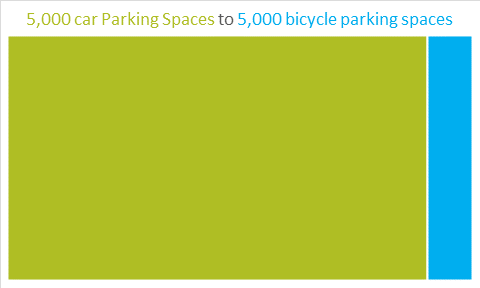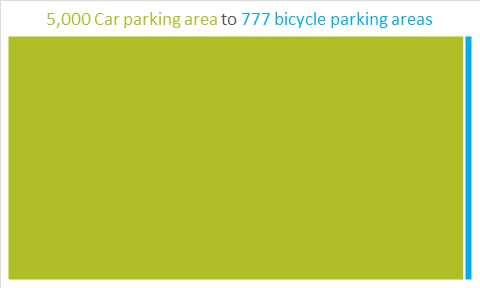
Six ECF proposals to further strengthen cycling in recast of Energy Performance of Buildings Directive
ECF publishes suggested amendments to the EU’s proposed revision of the Energy Performance of Buildings Directive, focusing on six key areas that could effectively increase the bicycle friendliness of buildings within the EU.
The European Cyclists’ Federation (ECF) has published a new document highlighting six key policy areas that can be improved to better integrate cycling into the Energy Performance of Buildings Directive (EPBD). The document is publicly available to download here on the ECF website.
While ECF fully supports the European Commission’s recent proposal to give cycling a much stronger role in the recast of the Directive, published on 15 December 2021, we believe there is still room for further improvement within the Commission’s proposal.
Our argument is grounded in the fact that cycling is the most energy efficient mode of transport, and providing easily accessible and secure parking infrastructure is just as critical for its regular use as charging infrastructure is for electric cars.
With this in mind, our proposed amendments can be broken this down across the following key points
1. Quantitative and qualitative bicycle parking requirements
Quantitative requirements: ECF suggests applying the proposal to have “at least one bicycle parking space for every car parking space” in non-residential buildings only to buildings where demand for bicycle parking will generally be highest, in particular office buildings and buildings owned or occupied by public authorities. In other types of non-residential buildings, we propose to apply this formula:
The number of bicycle parking spaces shall be twice the number of car places raised to the power of 0.7 (or 2x0.7, where x = car parking spaces).
This will lead to drastically lower numbers of bike parking against car parking in very large car parks. In return, get-out clauses for Member States need to be tightened.
This table gives an idea of how this works in practice when the formula is applied to the ratio of car/bicycle parking spaces.
1-to-1 car parking to bicycle parking ratio These two area graphs show the m2 area that would be taken by bicycle if the car parking spaces numbered 5,000 places, showing firstly the 1-to-1 ratio and then the suggested formula.

Bicycle parking places = Two times number of car places raised to the power of 0.7

Qualitative requirements: While criteria for car parking are very much the same across EU Member States, this is not the case for bicycle parking. Yet the quality of a bicycle parking space is the most important factor determining its use. We therefore suggest adding a definition on “bicycle parking space” as well as requiring Member States to develop quality bicycle parking requirements in their relevant national legislations. We also propose that for every ten bicycle parking spaces there shall be one parking space designed for bicycles with larger dimensions such as cargo bikes.
2. National renovation plans
ECF proposes to set national targets for building bicycle parking spaces covered by EPBD. This would form part of the Member States national renovation plan. Additionally, Member States that adjust their requirements for specific categories of non-residential buildings must explain in their national renovation plan how they will compensate for these adjustments in other non-residential buildings.
3. Scope of car parks
The Commission proposes to apply requirements related to recharging infrastructure and bicycle parking spaces to car parks adjacent to the building only (Article 12 “Infrastructure for sustainable mobility”). Requirements for car parks located inside the building, which are in the current Directive (EU) 2018/844 were deleted.
This proposal is not sensible. As land is very expensive, particularly in urban centres, many, if not most, new car parks are located underground inside the building.
4. "Get-out" clauses for Member States
Certain procedures at Member State level should be introduced to ensure that all possible measures are done to achieve the statutory number of bike parking spaces. In addition, we propose that lower numbers for certain types of non-residential buildings are compensated in other types of non-residential buildings.
5. Charging infrastructure for electric bicycles
The charging provisions in the current Directive, as well as in the proposed recast, all relate to “electric vehicles," though for e-cars only. No consideration is given to any other type of e-mobility, in particular e-bikes, which so far have seen by far the largest sales numbers of any type of electro-mobility in Europe. ECF proposes to introduce an amendment that would stipulate that the installation of charging infrastructure for electric bicycles shall match that of electric vehicles.
6. Wider mobility considerations
Proposed Article 12.9 still leaves much room for interpretation. ECF proposes to require Member States to review their relevant car parking policies and consider introducing maximum norms, in particular in those areas that are well served by public transport, walking and cycling.
Download ECF's full position paper on the integration of cycling into the EPBD here. Download ECF's suggested amendments to the European Commission's proposed revision of the EPBD here.
Regions:
Topics:
Contact the author
Recent news!
Upcoming events
Contact Us
Avenue des Arts, 7-8
Postal address: Rue de la Charité, 22
1210 Brussels, Belgium









